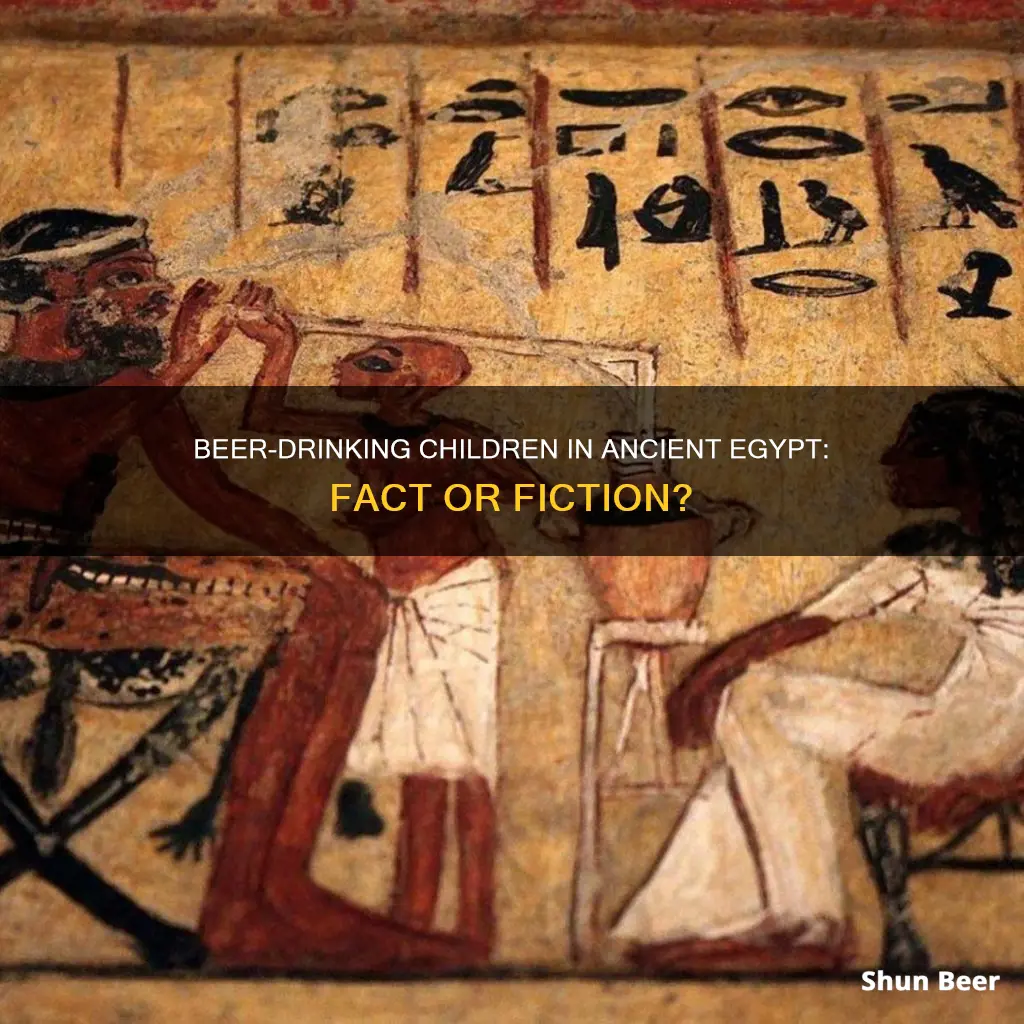
Beer was an integral part of ancient Egyptian society, with men, women, and children consuming it as a source of nutrition. It was considered a staple food and was enjoyed by both the wealthy and the poor. Beer was also used as compensation for labour, with workers at the Giza plateau receiving beer rations three times a day. The drink was so important that it was even offered to the gods, and several deities were associated with it.
| Characteristics | Values |
|---|---|
| Name | Hqt, heqet, heket, tnwm, tenemu, haAmt, kha-ahmet |
| Importance | Central importance to ancient Egyptian society |
| Consumption | Consumed by both adults and children |
| Diet | Staple drink of poor Egyptians but also part of wealthy Egyptians' diets |
| Offerings | Offered to the gods |
| Wages | Used as payment for work |
| Nutritional value | Thick, sweet, and nutritious |
| Alcohol content | Less alcohol than modern beers (c. 2-4%) |
| Served | Served at every Egyptian meal |
| Vessels | Shared between multiple people using long reed straws |
| Flavours | Flavoured with dates, honey, pomegranate juice, or powdered ochre |
| Festivals | Drunk during the annual Festival of Drunkenness |
What You'll Learn

Beer was considered nutritious and safer than water
Beer was a staple of the Egyptian diet, consumed by both adults and children. It was considered a source of nutrition and was safer to drink than water due to the lack of modern sanitation.
The ancient Egyptian brew was thick, dark red, and sweet, with an alcohol content of around 2-4%. It was made from bread, barley, emmer (wheat), yeast, and water. The bread was made from a rich, yeasty dough, which was lightly baked, crumbled into small pieces, and strained through a sieve with water. The addition of dates provided flavour and increased the alcohol content. The mixture was then fermented in a large vat and stored in ceramic jugs or terracotta vessels.
Beer was often consumed through long reed straws, which served both a social and practical purpose. The custom of drinking beer with straws is still practised in some African cultures that make beer in a similar manner. The straws were likely used to prevent the consumption of sediment, as well as for hygiene reasons, as multiple people often drank from the same vessel.
Beer was considered safer than water due to the lack of modern sanitation. In ancient Egypt, water purification methods were not as advanced as they are today, and drinking water could be contaminated with harmful bacteria or other impurities. Beer, on the other hand, underwent a fermentation process that killed any harmful bacteria, making it safer to consume.
In addition to its nutritional value, beer was also used as a form of payment for labour. Workers on the Great Pyramids at Giza received a daily ration of 4-5 litres of beer, which was considered a fair compensation for their work. Beer was also prescribed for medicinal purposes and was believed to have healing properties. It was frequently mentioned in medical texts, often as a way to "gladden the heart" or confuse evil spirits, which were thought to cause many diseases.
Overall, beer played a crucial role in ancient Egyptian society and was considered a nutritious and safer alternative to water. It was consumed by all members of society, regardless of age or social class, and was integral to both religious ceremonies and everyday life.
Drinking Beer on Shinkansen: What You Need to Know
You may want to see also

It was drunk by all ages and classes
Beer was a staple of the Egyptian diet, and it was consumed by all ages and classes. It was considered a source of nutrition and was safer to drink than water due to the lack of modern sanitation. Beer was also used as compensation for labour and was frequently prescribed for health reasons.
Labourers, including those who built the pyramids of Giza, were provided with a daily ration of beer—approximately 10 pints per day. Beer was also used as a form of payment for workers, with records indicating that workers at the Giza plateau received beer rations three times a day. This practice of paying workers with beer provides evidence that the great monuments were not built by slaves but by paid Egyptian labourers.
Beer was consumed by both adults and children, and it was considered a source of nutrition rather than just an intoxicant. It was a staple drink for poor Egyptians but was also central to the diet of wealthy Egyptians. Beer was also offered to the gods and was mentioned in the traditional offering formula.
Ancient Egyptian beer was made from barley and was thick, sweet, and nutritious. It had a low alcohol content, typically around 2%-4%, but stronger beers were also produced for religious festivals and ceremonies. Beer was consumed daily and played an essential role in religious festivals and celebrations.
The process of brewing beer was traditionally a female activity, often undertaken by women in their homes. Women would brew beer and bake bread, and they could earn extra money or barter goods for their families. Brewing later became a state-funded industry dominated by men.
Beer Drinking and Liver Cirrhosis: What's the Link?
You may want to see also

It was used as payment for labour
Beer was a staple of the Egyptian diet and was frequently used as payment for labour. Workers at the Giza plateau, for example, received beer rations three times a day as wages. Beer was also used as payment at various sites throughout Egypt, providing evidence that the great monuments were built by paid Egyptian labourers, not slaves.
The word for "payment for employment" in ancient Egyptian was "hemu", and the hieroglyph for a beer jug was used in the word. Beer was also used as currency in other ways. It was a common offering to the gods, and it was often supplied by the state for religious festivals. Beer was also considered a necessary offering for the dead and was included as a grave good in tombs.
Ancient Egyptian beer was thick, sweet, and nutritious. It was made from bread, barley, and emmer, and flavoured with dates. It was also safer to drink than water due to the lack of modern sanitation. It is believed to have had more nutrients and less alcohol than modern beers, with an alcohol content of around 2%.
Although beer was enjoyed at celebrations, it was also a part of the Egyptians' daily diet. It was consumed by all classes and ages and was considered a source of nutrition rather than just an intoxicant.
Beer and Kidney Health: One or Two?
You may want to see also

It was central to religious ceremonies
Beer was central to the religious ceremonies of ancient Egypt. It was considered a gift from the gods and was offered to statues of deities in temples. Beer was also mentioned in the traditional offering formula.
The ancient Egyptians believed that Osiris, the god of agriculture, invented beer. According to the myth, Osiris once made a decoction of barley that had germinated with the sacred waters of the Nile, but he was distracted and left it out in the sun. When he returned, the mixture had fermented, and he liked the taste so much that he shared it with humanity.
The Tekh Festival, or the Festival of Drunkenness, was one of the most popular festivals in Egypt. It was dedicated to Hathor, the goddess of love, dance, and beauty, who was also known as 'The Lady of Drunkenness'. During the festival, participants would drink to excess, fall asleep in a hall, and wake suddenly to the sound of drums. The alcohol was believed to lessen inhibitions and allow people to glimpse the goddess.
Beer was also mentioned as part of almost every major festival in ancient Egypt and was often supplied by the state. The festivals of Bastet, Hathor, and Sekhmet, in particular, involved vast quantities of beer and encouraged drinking to excess.
In addition to its role in festivals, beer was also used in funeral ceremonies. Funerals were a celebration of the life of the departed and included a picnic-banquet where guests would consume food and beer. The beer served at funerals was likely to have had a higher alcohol content than regular brew.
Beer and Hemorrhoids: Is There a Link?
You may want to see also

It was often flavoured with dates
Beer was a staple of the Egyptian diet, consumed by both adults and children. It was also used as compensation for labour, with workers at the Giza plateau receiving beer rations three times a day as payment.
The ancient Egyptian brewing process involved mixing cooked loaves of bread with water and placing the mixture in heated jars to ferment. The use of hops was unknown to the Egyptians, and the beer was flavoured with dates and honey to add sugar and taste, and yeast to increase fermentation. The resulting brew was thick, dark red, and sweet.
While beer was enjoyed at celebrations, it was also a part of the Egyptians' daily diet. It was considered a source of nutrition and was frequently prescribed for health reasons. It was also believed to confuse the evil spirits that were thought to cause many diseases.
The ancient Egyptian beer was likely to have been flavoured with dates, as dates were used to add sugar and taste to the brew. Dates were also used to increase the alcohol content of the beer. The addition of dates would have resulted in a thick, dark red, sweet beer.
The ancient Egyptians also added honey to their beer, which further increased the alcohol content. Honey was associated with the gods and was used to create a higher-quality brew for special occasions and banquets. The beer found in the tomb of the pharaoh Tutankhamun was a honey beer similar to the later European mead.
Beer and Depression: Exploring the Link
You may want to see also
Frequently asked questions
Yes, beer was consumed by both adults and children in Ancient Egypt.
No, although it was a staple for working-class Egyptians, beer was also central to the diet of wealthy Egyptians.
Yes, beer was treated principally as a type of food and was consumed daily.
No, Ancient Egyptian beer was thicker, sweeter, and more nutritious than modern beer. It was also less alcoholic, with an alcohol content of around 2-4%.







